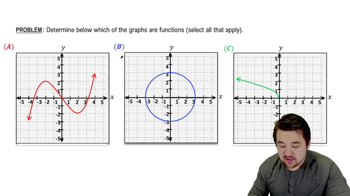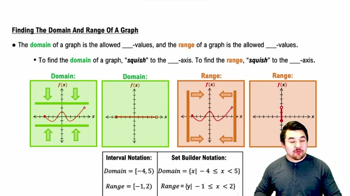Table of contents
- 0. Functions7h 52m
- Introduction to Functions16m
- Piecewise Functions10m
- Properties of Functions9m
- Common Functions1h 8m
- Transformations5m
- Combining Functions27m
- Exponent rules32m
- Exponential Functions28m
- Logarithmic Functions24m
- Properties of Logarithms34m
- Exponential & Logarithmic Equations35m
- Introduction to Trigonometric Functions38m
- Graphs of Trigonometric Functions44m
- Trigonometric Identities47m
- Inverse Trigonometric Functions48m
- 1. Limits and Continuity2h 2m
- 2. Intro to Derivatives1h 33m
- 3. Techniques of Differentiation3h 18m
- 4. Applications of Derivatives2h 38m
- 5. Graphical Applications of Derivatives6h 2m
- 6. Derivatives of Inverse, Exponential, & Logarithmic Functions2h 37m
- 7. Antiderivatives & Indefinite Integrals1h 26m
0. Functions
Introduction to Functions
Problem 75a
Textbook Question
A GPS device tracks the elevation E (in feet) of a hiker walking in the mountains. The elevation t hours after beginning the hike is given in the figure. <IMAGE>
Find the slope of the secant line that passes through points A and B. Interpret your answer as an average rate of change over the interval 1≤t≤3.
 Verified step by step guidance
Verified step by step guidance1
Identify the coordinates of points A and B from the given figure. Let's assume point A corresponds to t = 1 and point B corresponds to t = 3. The coordinates will be (1, E(1)) and (3, E(3)), where E(t) is the elevation at time t.
Recall that the slope of a secant line through two points (x1, y1) and (x2, y2) is given by the formula: \( m = \frac{y2 - y1}{x2 - x1} \).
Substitute the coordinates of points A and B into the slope formula: \( m = \frac{E(3) - E(1)}{3 - 1} \).
Simplify the expression: \( m = \frac{E(3) - E(1)}{2} \). This represents the average rate of change of elevation over the interval from t = 1 to t = 3.
Interpret the result: The slope of the secant line, \( m \), represents the average rate of change of the hiker's elevation in feet per hour over the time interval from 1 to 3 hours.
Recommended similar problem, with video answer:
 Verified Solution
Verified SolutionThis video solution was recommended by our tutors as helpful for the problem above
Video duration:
3mPlay a video:
Was this helpful?

 1:36m
1:36mWatch next
Master Introduction to Calculus Channel with a bite sized video explanation from Callie
Start learning





